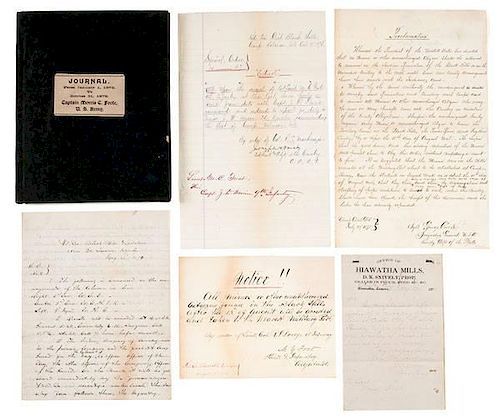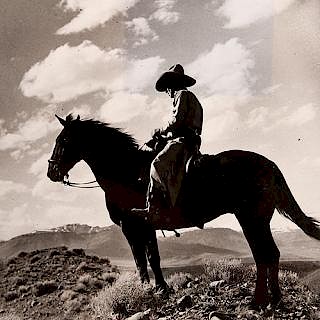M.C. Foote, 9th US Infantry, Archive Documenting Service in the American West, Ca 1872-1885, Including Exploration of the Black Hills
About Seller
6270 Este Ave.
Cincinnati , OH 45232
United States
With offices in Cincinnati, Cleveland and Denver, Cowan’s holds over 40 auctions each year, with annual sales exceeding $16M. We reach buyers around the globe, and take pride in our reputation for integrity, customer service and great results. A full-service house, Cowan’s Auctions specializes in Am...Read more
Two ways to bid:
- Leave a max absentee bid and the platform will bid on your behalf up to your maximum bid during the live auction.
- Bid live during the auction and your bids will be submitted real-time to the auctioneer.
Bid Increments
| Price | Bid Increment |
|---|---|
| $0 | $25 |
| $500 | $50 |
| $1,000 | $100 |
| $2,000 | $250 |
| $5,000 | $500 |
| $10,000 | $1,000 |
| $20,000 | $2,500 |
| $50,000 | $5,000 |
| $100,000 | $10,000 |
About Auction
Jun 12, 2015 - Jun 13, 2015
Cowan's Auctions dawnie@cowans.com
- Lot Description
Lot of approx. 50+ orders, letters and cards dating from about 1874 to 1876, plus two journals, 8 x 10 in. with flexible leather covers, each with paper label on front: Journal. From January 1, 1872 To October 31, 1878 / Captain Morris C. Foote, U.S. Army and Journal From November 1, 1878 To December 31, 1885, Captain Morris C. Foote, U.S. Army.
A number of orders relate to basic military functions, appointments (AAQM, ACS), taking recruits to various stations. There is a General Order pertaining to the order of units in the line in the Black Hills Expedition [May 24, 1875].
A Proclamation dated July 29, 1875 is a notice to miners and all others who do not have explicit permission to be there to leave the Black Hills by 15 August, by order of George Crook. There is also a manuscript notice, 6 x 8 in.: Notice!! All miners or other unauthorized citizens found in the Black Hills after the 15th of August will be arrested and taken to the nearest Military Post. By order of Lieut. Col. R. I. Dodge. The miners met on August 10 to discuss their plans/options. At the meeting they decided on a resolution thanking the army for the gentlemanly manner we have at all times been treated.
There are over a dozen papers relating to Lieut. Foote's health. Examination by an army surgeon determined that his lung hemorrhages required an extended leave of absence, at least 60 days, and a change of climate. The Army initially granted 7 days. Then a number of papers extended it to 30 days, then sixty days, etc. One of the forms attributed his lung condition to extended stays between 4000 and 7000 feet in altitude.
A few papers concern old business. A letter of Feb. 1875 is trying to correct an error from 1862. Foote was discharged as an enlisted man to accept a commission. He received the commission, but the discharge was never filed, so he was dropped from that unit's muster out rolls and classed as a deserter! (And yet he received other assignments and promotions!) It took over a dozen years to figure out, possibly because his commission as Captain of the 9th Infantry came up shortly after, and they were likely looking at his records. Another letter lets Foote know that his record in Washington had been corrected.
There are about a dozen letters from his mother, some rather hard to read (she writes crisscross if she runs out of paper). Most are personal - her health, the health of friends and neighbors, need for money, need for a new robe, a move to a new house, etc. There are a couple from his sister, Nannie, as well.
Two journals accompany the lot, but Foote does not include the month or year on every page, (i.e. many entries are simply noted "Saturday, 4th"), However, both have been transcribed, making his narrative much easier to follow. The earlier journal contains his notes from the second Black Hills Expedition.
June 3rd, Thursday. The Black Hills Geological, Topographical & Astronomical Surveying Party is composed of Prof. Jenney, Chief Geologist, Capt. Tuttle astronomer, Dr. McGillycuddy topographer, with their assistants and three or four practical miners - The military escort is composed of Co's C & I 2nd Cav. A,K,H & J 3rd Cav & H & C 9th Infy. numbering 438 enlisted men & 16 officers. Commanded by Lt. Col. R.I. Dodge Inf Staff composed of.....We have a train of about sixty wagons & ambulances, a Gatling gun, field howitzer, and about fifty civilian employees.
By Thurs., June 10th, they picked up Custer's trail from the previous summer and followed it for about the next week. He describes valleys filled with wildflowers, clear cold springs and streams; one day they got 16 deer. About the 14th, they encountered some miners. At first the men hid, then one came out with his rifle. He called out halt gentlemen, and we did so, after giving him an instant to see that we had no weapons in our hands, I advanced and spoke to him, said "good morning," which salutation was politely answered, while talking several others appeared from behind the rocks & trees, I said "I suppose you are miners, but you need not be afraid as I am not here now to arrest your." I asked them to show me some gold, they said they had sent a man in to Ft. Laramie the day before with all they had, but they would be happy to pan out some for me if I would go with them to the creek, while going down the comdg. officer came up and we all adjourned to the creek where one of them panned out two pans of gravel from a hole about 2 feet deep, producing some very fine specimens of gold Lon Camp 17 103 44 45 lat 43 46 20-53 Altitude 5620. They were very small, only worth two or three cents, but pure rich yellow gold, and at once convinced us that gold existed in the Black Hills, as Gen. Custer had reported....
Many letters written and received are mentioned in passing in the journal, including those during his time as Acting Indian Agent at Spotted Tail Agency. He repeats his count of the Indians when he notes that his survey is finished in September.
The second journal is from a bit quieter period. He does mention the news of Garfield's death on Sept. 20, 1881, and he went to a Garfield memorial service on the 26th.
By early March 1882, civil unrest required intervention by the Army. The Camp Dump Strike in Omaha, NE involved about 75 union workers on a railroad grading operation. They formed a picket line, looking for better pay. The Governor, Albinus Nance called in the state militia. One of the strikers by the name of Armstrong was killed by the militia (bayoneted) while trying to cross the picket line. The troops from Ft. Omaha were called. Foote writes: Sat. 11th Received orders at 10-30 a.m. and went to town with all available men, the Gatling gun & howitzer, stood under arms all day to protect workmen from rioters, returned to post at dark. March 12th Sunday. Quiet. Went down in Ambulance in the afternoon & interviewed Governor Nance. Called on officers at 5th Cav. Camp.
A couple weeks later he notes: Tues. 28th. Fine day. Moved into new house. Summoned as witness before the Grand Jury in killing of Citizen Armstrong by the militia, during the riots. Most of the rest is mundane activities "Went to town.; Busy at Hd. Qtrs.; Col. Anderson arrived. Typical entries for a "lifer" - given enough time, there are bursts of activity interspersed in a field of routine.
The Morris Cooper Foote Collection
Lots 140-152
Cowan’s is pleased to offer an important collection spanning 40 years of material—40 years of the life of the soldier Morris Cooper Foote, great grandson of Lewis Morris—a signer of the Declaration of Independence—and great nephew of novelist James Fenimore Cooper.
When the Civil War began, Foote joined the army at the age of 17 in his home state of New York, where he mustered into the 44th NY Volunteers, a group that came to be known as Ellsworth’s Avengers. After a promotion to 2nd Lieutenant and a transfer to the 92nd New York Volunteer Infantry, Foote was captured by the Confederate Army at the Battle of Plymouth in 1864 and was sent to Libby Prison. Eventually, Foote and many other POWs were sent to Charleston, S.C. where both Confederate and Federal forces attempted to use prisoners as human shields to discourage shelling—an incident now known as the “Immortal 600.” As one of the Federal officers placed under the fire of the northern batteries at Charleston, S.C., he was the only one wounded. From Charleston, Foote was transferred to Camp Sorghum in Columbia, South Carolina, where he escaped. He later published the story of his escape and loved to share it with family and friends. In the concluding stages of the war, he served as a staff officer at the surrender of Lee’s army at Appomattox.
After the Civil War, Foote entered the 9th U.S. Infantry on May 1866, and on March 7, 1867, received a promotion to the first lieutenancy. He served with his regiment in California, Alaska, Nevada, Arizona, New Mexico, Colorado, Wyoming and Nebraska. In Alaska, he commanded one of the two companies that received the territory from Russia in 1867. Foote also served in Native American campaigns and expeditions under Generals Miles and Crook, in Wyoming, New Mexico and Arizona. As part of Foote’s time in Wyoming, he took part in the exploration of The Black Hills a year before the events of Little Big Horn. He also conducted the first census of the Sioux Indians after the 1876 treaty as part of his duties as the commanding officer at the Spotted Tail Agency. After the discovery of gold in the Black Hills—an event that caused controversy between miners and Indians and eventually lead to tragedy—Foote attended a meeting of miners who, deciding to leave the area as requested after hearing a resolution from the President of the United States, went on to create Custer City (present day Custer), South Dakota, now considered to be the oldest town established by European Americans in the Black Hills. On January 26, 1883, Foote achieved the rank of captain of the 9th infantry. In September 1886, he witnessed the surrender of the Apache chief Geronimo to General Miles at Skeleton Canyon, Arizona.
Following the end of the Indian Wars, Foote’s regiment participated in the Spanish-American War. Foote commanded a battalion at the battle of San Juan Hill. At the formal surrender of Santiago, the commanding officer General Shafter selected the 9th infantry to receive the surrender of the city and province where Foote commanded a company stationed in the plaza. In August 1898, Foote received promotion to the rank of Major and orders to Boston on recruiting service, being unable to rejoin his regiment at the time due to suffering from Cuban malarial fever.
At the beginning of the twentieth century, the U.S. Army dispatched the 9th Infantry Regiment to China during the Boxer Rebellion and the China Relief Expedition, where Maj. Foote took part in the Battle of Tientsin.
After being appointed a Brigadier General on February 18, 1903, Foote retired the following day. Foote retired to Europe and resided in Geneva for two years. At the Hotel d’Angleterre, after recovering from double pneumonia and double pleurisy he passed away of heart failure on December 6, 1905.
As a soldier and an officer, Morris Cooper Foote experienced first-hand the moments that shaped our history and set the stage for the 20th century. This exceptional collection includes diaries, journals, letters, documents, books, photos, maps, prints, personal belongings, and more pertaining to his professional and personal life.Journals have internal hinges reinforced. Paper quality varies, as is typical. Letters typically very good.Condition
- Shipping Info
-
SHIPPING. At the request of the buyer, Cowan's will authorize the shipment of purchased items. Shipments usually occur within two weeks after payment has been received. Shipment is generally made via UPS Ground service. Unless buyer gives special instructions, the shipping method shall be at the sole discretion of Cowan's Auctions, Inc.. Cowan's is in no way responsible for the acts or omissions of independent handlers, packers or shippers of purchased items or for any loss, damage or delay from the packing or shipping of any property.
-
- Buyer's Premium



 EUR
EUR CAD
CAD AUD
AUD GBP
GBP MXN
MXN HKD
HKD CNY
CNY MYR
MYR SEK
SEK SGD
SGD CHF
CHF THB
THB















